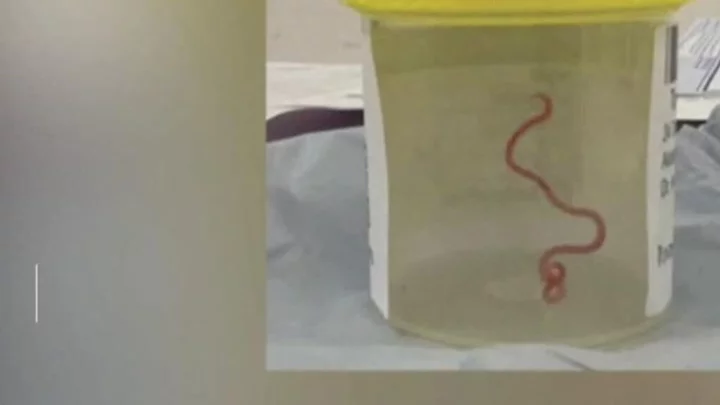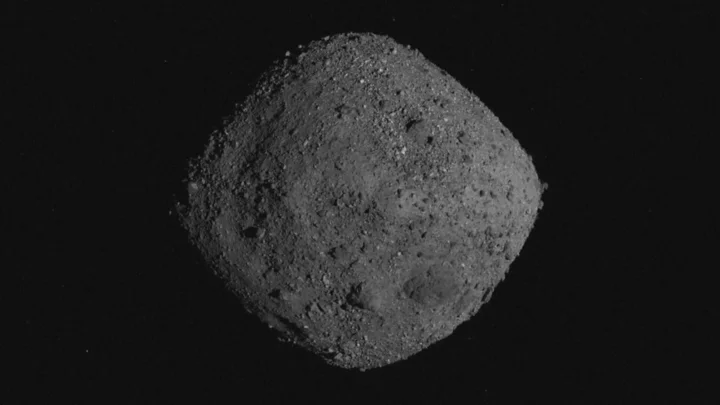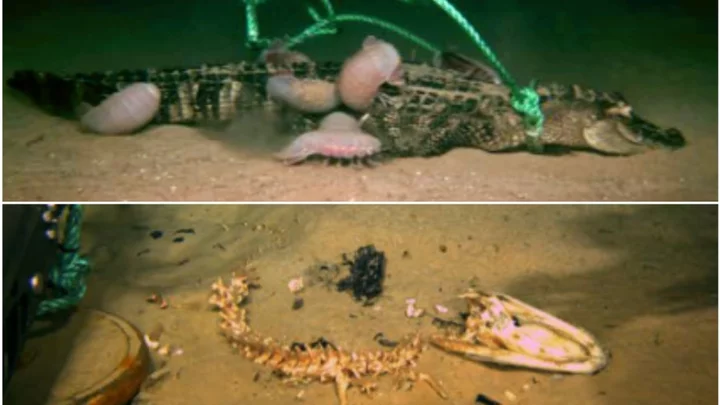
Modern Warfare 3 Perks: All Boots Explained
The new Modern Warfare 3 perk system contains five Boots that offer unique advantages, including increased movement speed and Dead Silence.
2023-10-06 01:49

New Warzone Map Urzikstan Revealed for Modern Warfare 3
Urzikstan was revealed during Call of Duty: NEXT as the newest Warzone map launching with Modern Warfare 3. Check out the first gameplay on Urzikstan and full list of points of interest.
2023-10-06 01:26

William hails ‘amazing’ eco-friendly start-up businesses
The Prince of Wales has hailed “amazing” eco-friendly start-up technology businesses in London. William was shown building material made from food waste during a visit to Sustainable Ventures, a working space which helps fund and support green firms, on Thursday afternoon. He remarked: “It’s amazing, and shows if we put our minds to something what we can discover.” William met businesses such as ENSO, which has created a more efficient electric vehicle tyre reducing harmful particles worn off during travel. ENSO was among the finalists of this year’s Earthshot Prize, established by William to find solutions to “repair” the planet. Founder Gunnlaugur Erlendsson said, after showing the prince a taxi which had the tyres, that the recognition has helped the business. William was also shown thermal imaging used to detect heat loss from buildings anywhere on Earth by firm SatVu. He later joined a discussion with start-ups to hear how Sustainable Ventures is helping them to expand. Among them was AirEx, which created the world’s first smart air brick to reduce home energy bills, and Depop, an online platform which allows users to buy and sell vintage and second-hand clothing. Since 2011, Sustainable Ventures, based in County Hall, near the Houses of Parliament, has supported over 500 businesses, including Notpla, one of the 2022 Earthshot Prize winners. It is dubbed the centre of the UK’s climate tech revolution and the largest hub of its type in Europe. Andrew Wordsworth, managing partner of Sustainable Ventures, who showed William around, said: “The Prince of Wales is known for his dedication to sustainability. “It’s inspiring for Sustainable Ventures’ members to know that someone of his influence understands that they need to scale to have impact in the next decade. “He has shown by his actions that we need optimistic solutions in a world dominated by negative headlines.” Read More Royal website subject to ‘denial of service attack’, royal source says TikTok finds and shuts down secret operation to stir up conflict in Ireland Spotify will not ban all AI-powered music, says boss of streaming giant Vehicle scam reports surged by 74% in the first half of 2023, says Lloyds Bank Standard Life confirms plans for pensions dashboard You need to update your new iPhone if you want to avoid it getting hot
2023-10-06 00:49

iPhone 15 update: Apple pushes new iOS 17 download to fix hot phones
Apple has finally pushed an update to the new iPhone 15 that should stop it running hot. In recent days, some owners of new iPhone 15 models, as well as the Pro and Max, reported that the devices appeared to be much warmer to the touch than expected. It prompted worry that the new design and materials in the iPhone 15 had caused it to be worryingly hot. Last week, however, Apple finally broke its silence on the problem. It said that many new iPhones could run hot for normal reasons – because they are setting themselves up, for instance – but also because of flaw in the new system software. “We have also found a bug in iOS 17 that is impacting some users and will be addressed in a software update,” the company said in a statement to Forbes. “Another issue involves some recent updates to third-party apps that are causing them to overload the system. We’re working with these app developers on fixes that are in the process of rolling out.” As well as confirming that the issue could be fixed with a new update, Apple said that it would not throttle performance. Previous reports that the issue could be fixed with a new version of iOS 17 had led to fears that would bring slower processing in an attempt to reach cooler temperatures. Now that update has finally arrived, in the form of iOS 17.0.3. It is available now, and can be downloaded through the Settings app as usual. The new update also brings fixes for security bugs that could be used by hackers to gain access to the phone. One is thought to have been “actively exploited” already, meaning that the update is an urgent fix. Read More Apple is preparing an urgent iPhone 15 update after they started overheating The mystery AI device that could replace your phone Zuckerberg says Metaverse can bring back the dead – virtually
2023-10-06 00:19

How to Get the Tactical DMR in Fortnite
Players can get the Tactical DMR in Fortnite by finding the new weapon in chests, vaults, ground loot, or Holo Chests.
2023-10-05 23:54

Dell's revenue forecast signals AI boost will take longer to materialize
(Reuters) -Dell Technologies on Thursday reiterated that it expects revenue to grow at a compounded annual rate of 3% to
2023-10-05 23:27

Scientists solve 5-year mystery of tiny unidentified 'sea creature'
Scientists have got to the bottom of a 5-year mystery after finally identifying a tiny sea creature captured on camera in 2018. It is the latest in a series of oceanic discoveries and experts recently observed “zombie worms” devour an alligator in an incredible experiment. For the tiny creature, the baffling question of its identity took a team of zoologists and parasitic worm specialists to solve after the small creature was pictured by an underwater photographer in 2018 off the coast of Okinawa in Japan. After photographer Ryo Minemizu captured the image, he shared it on social media asking the hive mind if they knew what the creature was, but everyone was left stumped. Minemizu was determined not to give up and instead went back to the area and was able to capture another ladybird-sized creature that was the same, or very similar, to the original one he had come across. The research team that was interested in identifying the sea creature approached him and Minemizu sent them the sample to research. Your browser does not support the video tag. Current Biology (2023) The team’s results were published in the Current Biology journal putting an end to the 5-year long mystery baffling experts. In a fascinating twist, the team found that the sample was not one, but two creatures that were clinging tightly to one another. Both were identified as types of cercariae parasitic larvae worms, with experts dubbing one as the “sailor” and the other as a “passenger” thanks to how they behave when they are connected. Passengers were much smaller than the sailors and when they were bonded together, they formed a flat-topped hemisphere shape. They squeeze their bodies together with heads facing the inside of the sphere, meanwhile, their tails latch onto one another. Experts believe the two individual creatures have created a colonial organism that suits both of their needs and according to the study's authors, “represents the first case of labor division in digenean larvae”. Sign up to our free Indy100 weekly newsletter Have your say in our news democracy. Click the upvote icon at the top of the page to help raise this article through the indy100 rankings.
2023-10-05 23:24

Earth hit by blast of energy from dead star so powerful that scientists can’t explain it
Earth has been hit by a blast from a dead star so energetic that scientists cannot explain it. The burst of gamma rays, originating in a dead star known as a pulsar, is the most high energy of its kind ever seen. It was equivalent about ten trillion times the energy of visible light, or 20 tera-electronvolts. Scientists are unable to explain exactly what kind of a scenario could lead a pulsar to emit such intense energy, and the researchers behind the breakthrough say that it “requires a rethinking of how these natural accelerators work”. Scientists hope that they can find yet more powerful energy blasts from pulsars, with a view to better understanding how they are formed. Pulsars are formed when a star dies, exploding in a supernova and leaving behind a tiny, dead star. They are just 20 kilometres across, and spin extremely fast with a powerful magnetic field. “These dead stars are almost entirely made up of neutrons and are incredibly dense: a teaspoon of their material has a mass of more than five billion tonnes, or about 900 times the mass of the Great Pyramid of Giza,” said Emma de Oña Wilhelmi, a scientist at the High Energy Stereoscopic System observatory in Namibia that detected the blast. As pulsars spin, they throw out beams of electromagnetic radiation, throwing it out like a cosmic lighthouse. That means that someone in one spot – like the Earth – will see the radiation pulses flash in a regular rhythm as they spin past. The radiation is thought to be the result of fast electrons that are produced and thrown out by the the pulsar’s magnetosphere, which is made up of plasma and electromagnetic fields that surround the star and spin with it. Scientists can search the radiation for different energy bands within the electromagnetic spectrum, helping them understand it. When scientists previously did that with the Vela pulsar examined in the new study, they found that it was the brightest everseen in the radio band, and the brightest persistent source in the giga-electronvolts. But the new research found that there is a part of the radiation with even more high energy components. “That is about 200 times more energetic than all radiation ever detected before from this object,” said co-author Christo Venter from the North-West University in South Africa. Scientists don’t know exactly how that could happen. 
“This result challenges our previous knowledge of pulsars and requires a rethinking of how these natural accelerators work,” says Arache Djannati-Atai from the Astroparticle & Cosmology (APC) laboratory in France, who led the research. “The traditional scheme according to which particles are accelerated along magnetic field lines within or slightly outside the magnetosphere cannot sufficiently explain our observations. “Perhaps we are witnessing the acceleration of particles through the so-called magnetic reconnection process beyond the light cylinder, which still somehow preserves the rotational pattern? But even this scenario faces difficulties to explain how such extreme radiation is produced.” An article describing the findings, ‘Discovery of a Radiation Component from the Vela Pulsar Reaching 20 Teraelectronvolts’, is published today in the journal Nature Astronomy. Read More ‘Ring of fire’ solar eclipse this month will be last until 2046 Mystery behind massive star suddenly vanishing decoded New discovery is ‘holy grail’ breakthrough in search for aliens, scientist say ‘Ring of fire’ solar eclipse this month will be last until 2046 Mystery behind massive star suddenly vanishing decoded New discovery is ‘holy grail’ breakthrough in search for aliens, scientist say
2023-10-05 23:16

X/Twitter removes key information about links because Elon Musk thinks it looks better
Elon Musk has stopped X, formerly Twitter, from showing information about links posted to the site. Until the last day, when someone posted a link on X, it showed as an image and the article’s headline, allowing people to see what they would be reading when they clicked. Now, however, that description has been removed. Instead, the article shows up as a normal picture, with the name of the website showing up small in the corner to show that it is a link. The update prompted confusion from many readers, who said that it was unclear whether a post included a link and what that might be a link to. Many news organisations publicly complained that it had forced them to change their strategy for posting on the site, given they could previously depend on Twitter to show the headline of posts. Many tweets that had included links and were posted before the change instantly became incomprehensible, since they had been written to respond to the headline that had pulled through from the article. Mr Musk has said that he ordered the change to improve the site. When the update was first rumoured, in a Forbes report in August, he responded by saying that it was “coming from me directly” and that it will “greatly improve the esthetics”. But it may also be an attempt to encourage users to stay on the site for longer, rather than clicking away to links. Since Mr Musk took over Twitter around a year ago, he has often focused on increasing the amount of time that users spend in its feed. “Our algorithm tries to optimize time spent on X, so links don’t get as much attention, because there is less time spent if people click away,” Mr Musk wrote in a recent tweet. “Best thing is to post content in long form on this platform.” It is also one of a range of recent decisions that looks to put Mr Musk in conflict with news sites. Earlier this year, for instance, X appeared to have added a delay when users clicked on some news sites and other rivals such as Instagram and Blue Sky. Users found that pages would not load for five seconds. Read More Musk confirms he is cutting election integrity staff from X/Twitter ahead of 2024 Reddit will start paying people to post X is shutting down feature to send posts to select people after privacy concern
2023-10-05 22:58

Scientists weren't expecting what they found when they opened up the Bennu asteroid capsule
In late September, scientists at NASA and around the world eagerly awaited the arrival of the OSIRIS-REx capsule containing a sample of the asteroid Bennu. The capsule safely landed on Earth on Sunday 24 September in a Utah desert containing a sample of the asteroid Bennu – categorised as one of the two “most hazardous known asteroids”. When the capsule was first opened, it sparked audible gasps from scientists. Since its arrival, NASA has kept its cards fairly close to its chest but a new blog post from the space agency suggests that progress is going slowly for the “best reason” as there is more sample material than they had anticipated. They explained: “The abundance of material found when the science canister lid was removed earlier this week has meant that the process of disassembling the TAGSAM (Touch-and-Go Sample Acquisition Mechanism) head – which holds the bulk of material from the asteroid – is off to a methodical start.” The OSIRIS-REx’s mission took 7 years to complete, with the sample currently being analysed by NASA taken three years ago before making its way down to Earth. Imagery from the moment the sample was taken confirmed to scientists that there would be asteroid material where they found it, but the quantity of dark particles were far more than they had anticipated. “The very best ‘problem’ to have is that there is so much material, it’s taking longer than we expected to collect it,” said deputy OSIRIS-REx curation lead Christopher Snead of NASA’s Johnson Space Center. “There’s a lot of abundant material outside the TAGSAM head that’s interesting in its own right. It’s really spectacular to have all that material there.” In the coming weeks, experts will continue to work through the particles and begin the complex process of carefully disassembling the TAGSAM to reach the bulk of the Bennu sample inside. Sign up to our free Indy100 weekly newsletter Have your say in our news democracy. Click the upvote icon at the top of the page to help raise this article through the indy100 rankings.
2023-10-05 22:48

VinFast revenues jump on EV sales to Vietnam affiliate
By Phuong Nguyen and Chavi Mehta (Reuters) -Vietnamese electric car maker VinFast said on Thursday its third-quarter revenue more than
2023-10-05 22:47

Monstrous 'zombie worms' devour alligator in jaw-dropping experiment
A warning to readers who don’t have a fear of the deep ocean: this story might soon change that. Back in 2019, a group of researchers who wanted to stir excitement down in the murky recesses of the sea conducted a unique experiment. The team, from the Louisiana Universities Marine Consortium (LUMCON), dropped three dead alligators 6,560 feet (2,000 metres) down into the Gulf of Mexico to see how deep-dwelling creatures would react to an uncommon food source. Initially, the scientists thought that the tough hide of the reptiles would put scavengers off, because it would make it hard for them to reach the more desirable soft flesh. However, this swiftly proved to be far from the case. Within a day, nine large isopods (Bathynomus giganteus) were observed feasting on the first carcass, eventually penetrating its hide and eating their meal from the inside out – imagine a crew of foot-long, pink woodlice crawling all over a gator and you get the picture. The second croc, dropped around 100km away, was almost totally devoured in just 51 days – leaving behind nothing more than its skull, spine, and the rope and weight that were used to anchor it to the sea floor. The scant leftovers became a source of great excitement to the researchers when they noticed it had been targeted by a brand new species of bone-eating worm. They concluded that it appeared to be a member of the Osedax family – commonly known as "zombie worms" because they suck away at, and live off, the bones of the dead – which had never been seen around Mexico before. Testing revealed that its nearest identifiable relatives are native to Antarctica and California, therefore making it an “undescribed species”. The investigators wrote in a paper about their discovery, which was published in the journal PLOS, that the creature “will be named in due course”. So, what happened to the third alligator? Well, that part is a mystery, because within eight days of its drop-off at its 1,996-metre-deep observation spot, it had disappeared. The researchers noted that although the body had vanished, the 20.4kg anchor, shackle and rope used to weigh the animal down were found 8.3 metres away – suggesting they had been “dragged” there. The experts concluded that a “large scavenger” had most likely snapped up the reptile. And given the depth at which it had been left, and the “implied body size necessary to both consume a moderately-sized alligator and move a large weight” it was probably a large shark. Clearly, whatever the beast was, it didn’t feel like sharing its dinner with a bunch of greedy worms. Sign up for our free Indy100 weekly newsletter Have your say in our news democracy. Click the upvote icon at the top of the page to help raise this article through the indy100 rankings.
2023-10-05 21:58
